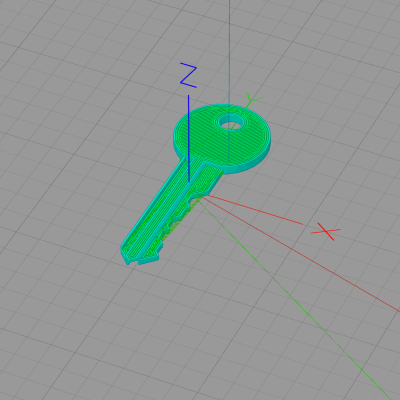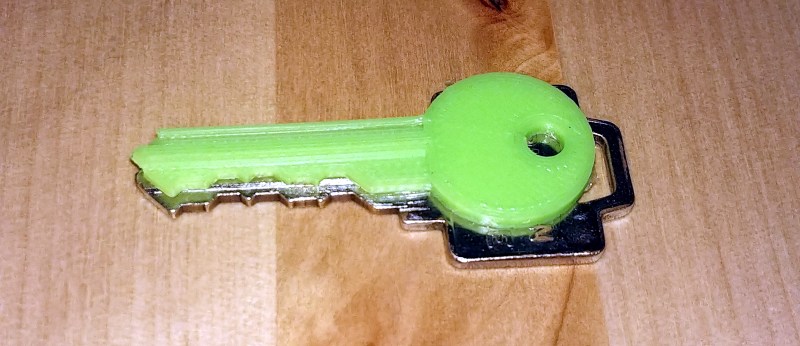Good ol’ Kwikset-standard locks were introduced in 1946 and enjoyed a decades-long security by obscurity. The technology still stands today as a ubiquitous and fairly minimal level of security. It’s the simplest of the various standards (e.g., Master, Schlage, etc.) with a mere five pins with values ranging from 1 (not cut down hardly at all) to 7 (cut deeply). This relative simplicity made the Kwikset the ideal platform for [Dave Pedu] to test his 3D-printed keys.
 Rather than simply duplicating an existing key, [Dave] created a parametric key blank in OpenSCAD; he just enters his pin settings and the model generator creates the print file. He printed ABS on a glass plate with a schmeer of acetone on it, and .15mm layer heights. Another reason [Dave] chose Kwikset is that the one he had was super old and super loose — he theorizes that a newer, tighter lock might simply break the key.
Rather than simply duplicating an existing key, [Dave] created a parametric key blank in OpenSCAD; he just enters his pin settings and the model generator creates the print file. He printed ABS on a glass plate with a schmeer of acetone on it, and .15mm layer heights. Another reason [Dave] chose Kwikset is that the one he had was super old and super loose — he theorizes that a newer, tighter lock might simply break the key.
So, a reminder: Don’t post a picture of your keys on the socials since at this point it’s certainly possible to script the entire process from selecting a picture to pulling the key off the print bed. Looking to technology won’t save you either; Bluetooth locks aren’t much better.
















Parametric. Sweet!
Parametric models are rather easy to make using openscad.
I used them to replicate the key for my safe deposit box (https://github.com/feuerrot/openscad/blob/master/keys/sk_aachen.scad) and the printed key works quite well: https://vimeo.com/87711820
I have the big padlocks that take Kwikset keys and they match the house. Very handy. I’ll stop by ACE and use their little measuring template on a key!
Well it’s not like they were safe from raking…. but now I guess any muggle can get in.
“Good ol’ Kwikset-standard locks were introduced in 1946 and enjoyed a decades-long security by obscurity. The technology still stands today as a ubiquitous and fairly minimal level of security.”
Good for practicing one’s lock-picking skills on.
This is cool and I can’t wait to try this out.
Not to be nit picky, but I couldn’t help noticing that the 3D key in the photo is laying on top of a Weiser key, not a Kwikset. Weiser was a competing manufacturer that was purchased by Kwikset a few years back. Kwikset keys had a thinner profile and and would enter Weiser locks but the cut position and depths were substantially different.
Kwikset locks have relatively loose tolerances right out of the box, so if the keys work in old Kwiksets, they should work just fine in new ones. I’ll be curious to see how well a key printed with PLA works.
Kwikset also makes a 6 pin version of their key, which is used in their current SmartKey locks, so if the OpenScad file of Dave’s includes the parameter for a sixth space, it should work for those as well.
Kwikset, Dexter, Weiser and Arrow use the same keyway. Blanks are interchangeable. Titan is another brand made by Kwikset.
Love this response! I used a true Kwikset KW1 key set as the reference for the development of this project. However, I wasn’t comfortable imaging the actual key to my front door. So I used a key from my keychain – to a shed across the country – that my code easily replicated the appearance of.
I haven’t actually heard of this standard – perhaps it will be the next layout my generator supports!
I wonder how well a key shape can be cast in aluminum?
As well as any long thin thing ….
https://78.media.tumblr.com/92f1fd24c1c632c983e27f04d160c607/tumblr_mmrss9VMVj1s6aepxo1_250.gif
Now all we need is a program to get the pin settings from a picture.
2, 4, 4, 2, 3
That’s decade old tech. If you can id the manufacturer any good locksmith could do it by eye.
Why bother, just use a “bump key” and the back end of a plastic screwdriver.
I used to just jam a #2 slotted screwdriver into the lock and give it a good, hard twist. Never found a Kwikset lock that I couldn’t break fairly easily. Following that I would replace the knob and lock with something decent, usually Medeco.
Quote [John Baichtal]: “with a mere five pins with values ranging from 1 (not cut down hardly at all) to 7 (cut deeply)”
So that would be 7^5+1 permutations. (16808).
I’ll bet you believe it’s 7^5 permutations! (16807)
When I was a drinker going to a pub I had an issue with keys. Well rather they had an issue with me and always seemed to run away somewhere.
It was a frequent occurrence that I would break into my own home (usually damaging something) and the next morning I would go and buy yet another blank key and find the spare key (inside) cut a duplicate with a file.
Eventually I got sick of this and that is where the extra permutation came in.
I bought a blank key and some brass rod that was the diameter of the tumblers and re-cut tumblers to fit the blank key. Now I could buy a spare key anywhere without needing to have an original and without needing to have it cut!
I’ll be over tomorrow with a bunch of blank keys! When do you leave for work?
There are only 4 different blank keys for the common door locks here. They are the 4 permutations of left and right versions with flat or slightly curved tumbler actuator shaft.
The ones we have here are only 5 tumblers and about 4 heights which greatly reduces the permutations and they are very easy to pick but no one would bother to pick them as you can open a front house door with a piece of the right flexibility/hardness plastic faster than you can take a key out of your pocket.
In that regard your really not loosing any security by using a lock that fits a blank key as you never had any security to start with.
Like the saying goes, locks only keep the honest people out.
Here in Finland, pretty much all apartments have some variant of Abloy-style disc tumblers. Generally it is regarded easier to break a window/door than to pick the lock, though exploits do exist for some of the older ones. Also has the benefit that you have some evidence of burglary for insurance purposes.
Not even that many permutations. They have limits on the difference between depth so you wouldn’t go from a 1 to a 7 or the key risk getting stuck.
or not having 7 next to the stub (shoulder) so the key doen’t snap off in the lock
There are quite a few locks you can buy that are actually secure. Abloy Protec Disk Detainer locks are up there as one of the best and I doubt you could copy the key for a Protec as easily as you can for a Kwikset…
“Don’t post a picture of your keys on the socials”. That’s an old and famous story. By now, everybody learnt that lesson. Or not.
https://www.eevblog.com/forum/chat/what-interestingfunnyengineering-specific-key-chain-do-you-have/
:o)
There have been a few programs like this but all limited to one type of key.
The problem is the keyways and blank profiles.
Does anyone here know where to get the key blank profiles? Are there lists of all profiles?
With this and the pin spacing and pin dept it would be trivial to make a program for all keys.
I know instacode has a great database for these things. It’s more for looking up key codes and bitting.
I forgot to post how awesome this little program is.
Also to make a few links to reasons not to post pictures of keys.
Jos Weyers has a few talks on this subject worthy of watching.
https://www.youtube.com/watch?v=muINcnhj1EQ
There once was a website called pleasebreak.in Not sure where it has gone.
It posted keys with the actual location of the house. All public information ripped from twitter.
It’s not like before 3D printers people could not copy keys from pictures.
If you know the scale you can just grind it in a bit of metal after all.
Print out picture in right orientation (after fixing perspective) and right size, lay it on a bit of metal, and voilà.
It’s actually a lot easier than that.
Most common keys have five heights and they can easy be seen and read by just looking at the key or picture of a key.
Now get a barrel or two and it has the other dimensions. You can remove the tumblers and inset the blank key then use a thin pen through the tumbler holes to mark the tumbler centers on the blank.
With 5 heights and 5 to 7 tumblers you wont have to pull may barrels apart before you have a tumbler of each height.
Just make a lock by choosing the tumblers combination that matches the key in the picture and then just file the blank until all the tumblers are flat with the barrel.
Or yo use a bump key :)
Well if you *have to* make a key then that’s an easy way to do it.
But for most common door locks, I can open the door with a piece of plastic faster than I can take a bump key from my pocket.
Locks, deadbolts, they’ll all rather pointless
https://youtu.be/NJqpdZJA8iM
The Kwikset standard actually includes pin heights 0-9 now.
That should make them jam up much sooner as they wear.
I bought a Proxxon CNC mill from a dude whose locksmithing business revolved around CNC cutting keys just from the code by mail order – pretty sure automobile rescue companies (AA and RAC in the UK) have similar setups to cut car keys on the move (as seen in one of their adverts).
I was hoping you could post the full source code files in English& give a tutorial not your keys no but just a template as I did not get the whole code in the image